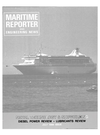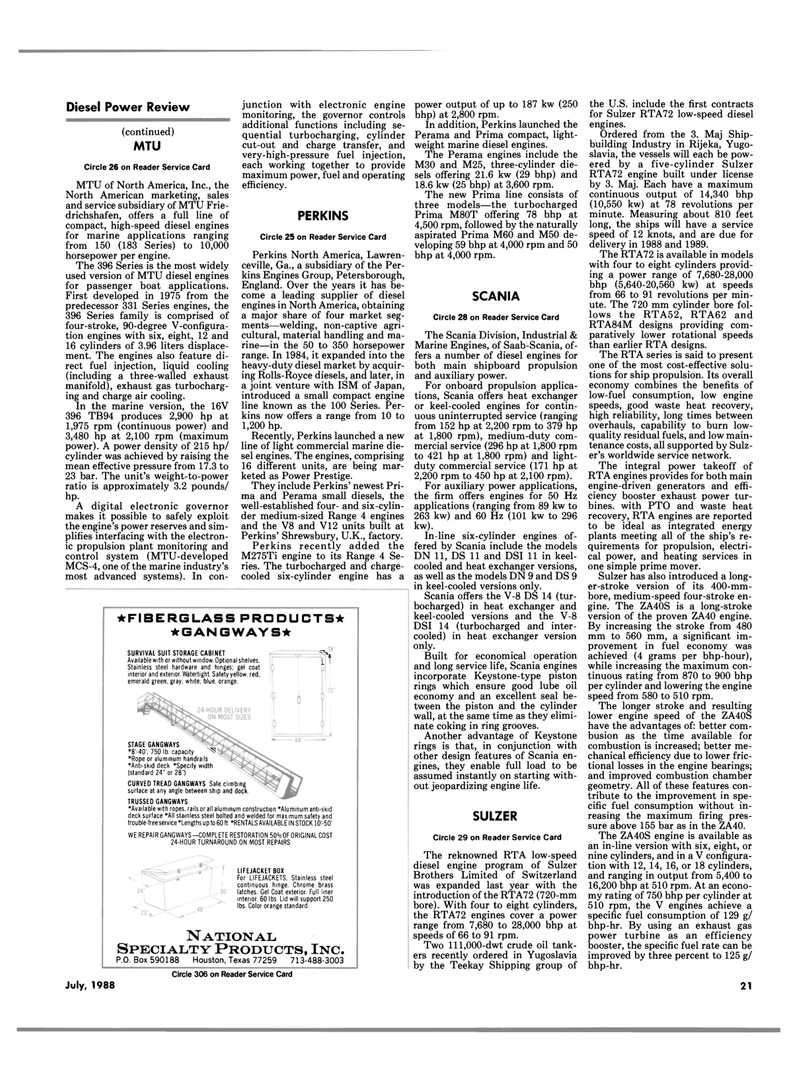
Page 13: of Maritime Reporter Magazine (July 1988)
Read this page in Pdf, Flash or Html5 edition of July 1988 Maritime Reporter Magazine
Diesel Power Review (continued)
MTU
Circle 26 on Reader Service Card
MTU of North America, Inc., the
North American marketing, sales and service subsidiary of MTU Frie- drichshafen, offers a full line of compact, high-speed diesel engines for marine applications ranging from 150 (183 Series) to 10,000 horsepower per engine.
The 396 Series is the most widely used version of MTU diesel engines for passenger boat applications.
First developed in 1975 from the predecessor 331 Series engines, the 396 Series family is comprised of four-stroke, 90-degree V-configura- tion engines with six, eight, 12 and 16 cylinders of 3.96 liters displace- ment. The engines also feature di- rect fuel injection, liquid cooling (including a three-walled exhaust manifold), exhaust gas turbocharg- ing and charge air cooling.
In the marine version, the 16V 396 TB94 produces 2,900 hp at 1,975 rpm (continuous power) and 3,480 hp at 2,100 rpm (maximum power). A power density of 215 hp/ cylinder was achieved by raising the mean effective pressure from 17.3 to 23 bar. The unit's weight-to-power ratio is approximately 3.2 pounds/ hp.
A digital electronic governor makes it possible to safely exploit the engine's power reserves and sim- plifies interfacing with the electron- ic propulsion plant monitoring and control system (MTU-developed
MCS-4, one of the marine industry's most advanced systems). In con- junction with electronic engine monitoring, the governor controls additional functions including se- quential turbocharging, cylinder cut-out and charge transfer, and very-high-pressure fuel injection, each working together to provide maximum power, fuel and operating efficiency.
PERKINS
Circle 25 on Reader Service Card
Perkins North America, Lawren- ceville, Ga., a subsidiary of the Per- kins Engines Group, Petersborough,
England. Over the years it has be- come a leading supplier of diesel engines in North America, obtaining a major share of four market seg- ments—welding, non-captive agri- cultural, material handling and ma- rine—in the 50 to 350 horsepower range. In 1984, it expanded into the heavy-duty diesel market by acquir- ing Rolls-Royce diesels, and later, in a joint venture with ISM of Japan, introduced a small compact engine line known as the 100 Series. Per- kins now offers a range from 10 to 1,200 hp.
Recently, Perkins launched a new line of light commercial marine die- sel engines. The engines, comprising 16 different units, are being mar- keted as Power Prestige.
They include Perkins' newest Pri- ma and Perama small diesels, the well-established four- and six-cylin- der medium-sized Range 4 engines and the V8 and V12 units built at
Perkins' Shrewsbury, U.K., factory.
Perkins recently added the
M275Ti engine to its Range 4 Se- ries. The turbocharged and charge- cooled six-cylinder engine has a • FIBERGLASS PRODUCTS* •GANGWAYS*
SURVIVAL SUIT STORAGE CABINET
Available with or without window. Optional shelves.
Stainless steel hardware and hinges; gel coat interior and exterior. Watertight. Safety yellow, red, emerald green, gray, white, blue, orange. fl
STAGE GANGWAYS *8'-40', 750 lb. capacity ^ *Rope or aluminum handrails •Anti-skid deck 'Specify width (standard 24" or 28")
CURVED TREAD GANGWAYS Safe climbing surface at any angle between ship and dock.
TRUSSED GANGWAYS 'Available with ropes, rails or all aluminum construction 'Aluminum anti skid deck surface 'All stainless steel bolted and welded for maximum safety and trouble-free service 'Lengths up to 60 ft. 'RENTALS AVAILABLE IN STOCK 10'-50'
WE REPAIR GANGWAYS-COMPLETE RESTORATION 50%OF ORIGINAL COST 24-HOUR TURNAROUND ON MOST REPAIRS
LIFEJACKET BOX
For LIFEJACKETS. Stainless steel continuous hinge. Chrome brass latches. Gel Coat exterior. Full liner interior. 60 lbs. Lid will support 250 lbs. Color orange standard.
NATIONAL
SPECIALTY PRODUCTS, INC.
P.O. Box 590188 Houston, Texas 77259 713-488-3003
Circle 306 on Reader Service Card power output of up to 187 kw (250 bhp) at 2,800 rpm.
In addition, Perkins launched the
Perama and Prima compact, light- weight marine diesel engines.
The Perama engines include the
M30 and M25, three-cylinder die- sels offering 21.6 kw (29 bhp) and 18.6 kw (25 bhp) at 3,600 rpm.
The new Prima line consists of three models—the turbocharged
Prima M80T offering 78 bhp at 4,500 rpm, followed by the naturally aspirated Prima M60 and M50 de- veloping 59 bhp at 4,000 rpm and 50 bhp at 4,000 rpm.
SCANIA
Circle 28 on Reader Service Card
The Scania Division, Industrial &
Marine Engines, of Saab-Scania, of- fers a number of diesel engines for both main shipboard propulsion and auxiliary power.
For onboard propulsion applica- tions, Scania offers heat exchanger or keel-cooled engines for contin- uous uninterrupted service (ranging from 152 hp at 2,200 rpm to 379 hp at 1,800 rpm), medium-duty com- mercial service (296 hp at 1,800 rpm to 421 hp at 1,800 rpm) and light- duty commercial service (171 hp at 2,200 rpm to 450 hp at 2,100 rpm).
For auxiliary power applications, the firm offers engines for 50 Hz applications (ranging from 89 kw to 263 kw) and 60 Hz (101 kw to 296 kw).
In-line six-cylinder engines of- fered by Scania include the models
DN 11, DS 11 and DSI 11 in keel- cooled and heat exchanger versions, as well as the models DN 9 and DS 9 in keel-cooled versions only.
Scania offers the V-8 DS 14 (tur- bocharged) in heat exchanger and keel-cooled versions and the V-8
DSI 14 (turbocharged and inter- cooled) in heat exchanger version only.
Built for economical operation and long service life, Scania engines incorporate Keystone-type piston rings which ensure good lube oil economy and an excellent seal be- tween the piston and the cylinder wall, at the same time as they elimi- nate coking in ring grooves.
Another advantage of Keystone rings is that, in conjunction with other design features of Scania en- gines, they enable full load to be assumed instantly on starting with- out jeopardizing engine life.
SULZER
Circle 29 on Reader Service Card
The reknowned RTA low-speed diesel engine program of Sulzer
Brothers Limited of Switzerland was expanded last year with the introduction of the RTA72 (720-mm bore). With four to eight cylinders, the RTA72 engines cover a power range from 7,680 to 28,000 bhp at speeds of 66 to 91 rpm.
Two 111,000-dwt crude oil tank- ers recently ordered in Yugoslavia by the Teekay Shipping group of
July, 1988 the U.S. include the first contracts for Sulzer RTA72 low-speed diesel engines.
Ordered from the 3. Maj Ship- building Industry in Rijeka, Yugo- slavia, the vessels will each be pow- ered by a five-cylinder Sulzer
RTA72 engine built under license by 3. Maj. Each have a maximum continuous output of 14,340 bhp (10,550 kw) at 78 revolutions per minute. Measuring about 810 feet long, the ships will have a service speed of 12 knots, and are due for delivery in 1988 and 1989.
The RTA72 is available in models with four to eight cylinders provid- ing a power range of 7,680-28,000 bhp (5,640-20,560 kw) at speeds from 66 to 91 revolutions per min- ute. The 720 mm cylinder bore fol- lows the RTA52, RTA62 and
RTA84M designs providing com- paratively lower rotational speeds than earlier RTA designs.
The RTA series is said to present one of the most cost-effective solu- tions for ship propulsion. Its overall economy combines the benefits of low-fuel consumption, low engine speeds, good waste heat recovery, high reliability, long times between overhauls, capability to burn low- quality residual fuels, and low main- tenance costs, all supported by Sulz- er's worldwide service network.
The integral power takeoff of
RTA engines provides for both main engine-driven generators and effi- ciency booster exhaust power tur- bines. with PTO and waste heat recovery, RTA engines are reported to be ideal as integrated energy plants meeting all of the ship's re- quirements for propulsion, electri- cal power, and heating services in one simple prime mover.
Sulzer has also introduced a long- er-stroke version of its 400-mm- bore, medium-speed four-stroke en- gine. The ZA40S is a long-stroke version of the proven ZA40 engine.
By increasing the stroke from 480 mm to 560 mm, a significant im- provement in fuel economy was achieved (4 grams per bhp-hour), while increasing the maximum con- tinuous rating from 870 to 900 bhp per cylinder and lowering the engine speed from 580 to 510 rpm.
The longer stroke and resulting lower engine speed of the ZA40S have the advantages of: better com- busion as the time available for combustion is increased; better me- chanical efficiency due to lower fric- tional losses in the engine bearings; and improved combustion chamber geometry. All of these features con- tribute to the improvement in spe- cific fuel consumption without in- reasing the maximum firing pres- sure above 155 bar as in the ZA40.
The ZA40S engine is available as an in-line version with six, eight, or nine cylinders, and in a V configura- tion with 12, 14, 16, or 18 cylinders, and ranging in output from 5,400 to 16,200 bhp at 510 rpm. At an econo- my rating of 750 bhp per cylinder at 510 rpm, the V engines achieve a specific fuel consumption of 129 g/ bhp-hr. By using an exhaust gas power turbine as an efficiency booster, the specific fuel rate can be improved by three percent to 125 g/ bhp-hr. 21

 12
12

 14
14
